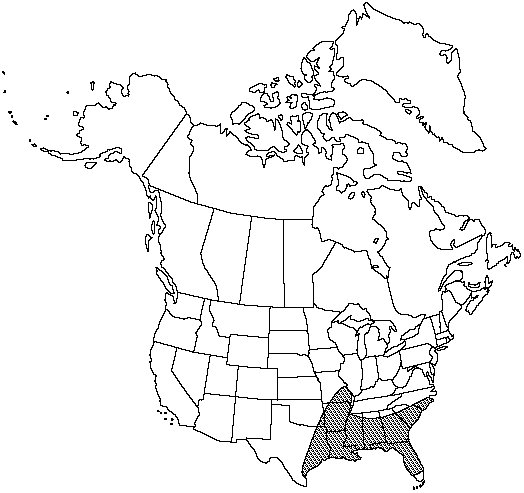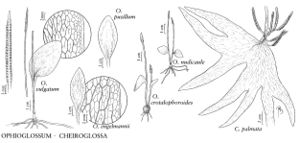Difference between revisions of "Ophioglossum crotalophoroides"
Fl. Carol. 256. 1788.
FNA>Volume Importer |
FNA>Volume Importer |
||
| Line 24: | Line 24: | ||
|elevation=0-100 m | |elevation=0-100 m | ||
|distribution=Ala.;Ark.;Fla.;Ga.;La.;Miss.;Mo.;N.C.;S.C.;Tex.;widespread in tropical highlands;Mexico;West Indies;Central America;South America. | |distribution=Ala.;Ark.;Fla.;Ga.;La.;Miss.;Mo.;N.C.;S.C.;Tex.;widespread in tropical highlands;Mexico;West Indies;Central America;South America. | ||
| − | |discussion=<p>Ophioglossum crotalophoroides is very remarkable morphologically for its highly modified stem and threadlike nonproliferous roots. The gametophyte is disclike (M.R. Mesler 1973). It is especially common in lawns and cemeteries in the southeastern United States.</p> | + | |discussion=<p><i>Ophioglossum crotalophoroides</i> is very remarkable morphologically for its highly modified stem and threadlike nonproliferous roots. The gametophyte is disclike (M.R. Mesler 1973). It is especially common in lawns and cemeteries in the southeastern United States.</p> |
|tables= | |tables= | ||
|references= | |references= | ||
| Line 48: | Line 48: | ||
|publication year=1788 | |publication year=1788 | ||
|special status= | |special status= | ||
| − | |source xml=https://jpend@bitbucket.org/aafc-mbb/fna-data-curation.git/src/ | + | |source xml=https://jpend@bitbucket.org/aafc-mbb/fna-data-curation.git/src/8f726806613d60c220dc4493de13607dd3150896/coarse_grained_fna_xml/V2/V2_33.xml |
|genus=Ophioglossum | |genus=Ophioglossum | ||
|species=Ophioglossum crotalophoroides | |species=Ophioglossum crotalophoroides | ||
Revision as of 16:47, 18 September 2019
Roots to 20 per plant, blackish, usually extremely narrow, often almost hairlike, less than 0.1 mm diam., proliferations not reported. Stems spheric, 3-12 mm diam., succulent, cormlike with perforation at apex, apical meristem located at bottom of cavity through which leaves emerge at top, leaves 2 per stem. Trophophore stalk to 0.6cm, 0.1-0.2 times as long as trophophore blade. Trophophore blade lying nearly flat on ground, not folded longitudinally, pale green throughout, deltate to cordate, to 3 × 2 cm, contracted abruptly at truncate to cordate base, apex with apiculum. Venation coarsely reticulate with included veinlets. Sporophores arising at ground level, 1-5 times as long as trophophore; sporangial clusters usually short, less than 1 cm, 2-3 mm wide, with 3-8 pairs of sporangia, apiculum to 1.5 mm.
Phenology: Leaves appearing mainly in late winter and early spring, sometimes also appearing later in season after heavy rains.
Habitat: Second-growth fields, vacant lots, roadside ditches, and lawns
Elevation: 0-100 m
Distribution

Ala., Ark., Fla., Ga., La., Miss., Mo., N.C., S.C., Tex., widespread in tropical highlands, Mexico, West Indies, Central America, South America.
Discussion
Ophioglossum crotalophoroides is very remarkable morphologically for its highly modified stem and threadlike nonproliferous roots. The gametophyte is disclike (M.R. Mesler 1973). It is especially common in lawns and cemeteries in the southeastern United States.
Selected References
None.
